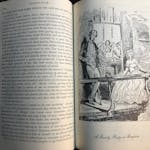There's life after childhood after all. And for Steve Rushin, life is good.
In his 2017 memoir, "Sting-Ray Afternoons," the Sports Illustrated writer and author reminisced about growing up in 1970s Bloomington. The book ended as the '80s dawned, and a way of life seemed to have faded out with the previous decade, along with the shuttering of nearby Met Stadium.
Now, Rushin says, he's returned to answer the question, "Whatever happened to that kid?" Volume 2, "Nights in White Castle," picks up in 1983 as he begins his senior year at Kennedy High School. And in some ways, the sequel is better than the original.
The White Castle is the one at 96th Street and Lyndale Avenue S. (still extant), the preferred hangout for Rushin and his friends. And the first half of the book has enough '80s Twin Cities touchstones to again send locals into a nostalgic dream state: Red Owl, Wally McCarthy's Lindahl Olds, the Carlton Celebrity Room.
"Nights" benefits from more of a built-in narrative this time, as Rushin moves from Bloomington to Marquette University in Milwaukee and then, about as fast you can say "you're hired," to a job at Sports Illustrated in New York. There are still a few digressions, such as an obsession with the Minneapolis Star and Tribune's cable TV listings, but fewer than in "Sting-Ray."
Sports fans won't find a lot of big-time behind-the-scenes sports anecdotes, other than the Kennedy Eagles' 1984 run to the state boys' basketball tournament with 6-foot-4 Rushin at forward.
But his basketball career didn't end there, thanks to a nearby resident in Bloomington's South Brook neighborhood: Flip Saunders, the future Timberwolves coach, then working as an assistant to coach Jim Dutcher at the University of Minnesota. Soon Rushin and his buddies are playing three-on-three summer hoops in Saunders' backyard, contesting for an aluminum-foil trophy in the Saunders Hoop Invitational Tournament. (Supply your own acronym.) That sets in motion a sequence of events that lands Rushin at SI after college in 1988.
Rushin affects a sort of Midwestern "Gosh, how did this happen to me?" about much of this. But give him credit for more pluck than that.
Knock on a door, and Flip Saunders opens it. (His wife, Debbie, actually.) Write a letter to the editor of Sports Illustrated, and senior writer Alexander Wolff writes back. Place a phone call to New Jersey, and billiards legend Willie Mosconi picks up, giving Rushin his first SI byline before he was even on staff. These things don't just happen.
As SI readers know, Rushin's strength is his descriptive and playful prose. The White Castle has a "white porcelain exterior hinting at the lavatorial exertions to come." Marquette's McCormick Hall is "a cylindrical high-rise dorm that resembles a 16-ounce tall boy of Old Milwaukee." (Side note from Milwaukee: McCormick is being torn down this year.)
But we move from one moment to the next, one anecdote to another, so briskly that besides Rushin himself, we don't get to know the people in the stories that well, as we did his family in "Sting-Ray." When Saunders enters Rushin's life, you get a sense of Saunders' open and embracing nature, but we're never privy to a conversation that gives us real insight into him, or into their friendship.
Rushin would become a senior writer and columnist at SI, staying until 2007, when he departed to focus on his book career. He returned as a contributing writer a few years later. But "Nights in White Castle" closes as his sportswriting career just gets underway, with just a few quick anecdotes about his first travels leaving room for more. Volume 3, perhaps?
Casey Common is an editor at the Star Tribune.
Nights in White Castle
By: Steve Rushin.
Publisher: Little, Brown, 308 pages, $28.
Events: Book launch, 7 p.m. Aug. 20, Magers & Quinn, 3038 Hennepin Av. S., Mpls.; Literature Lovers Night Out, Nov. 16-17, tickets at bit.ly/2LC9txX





